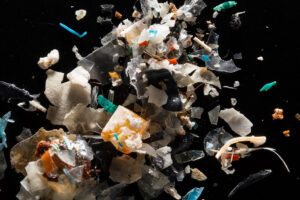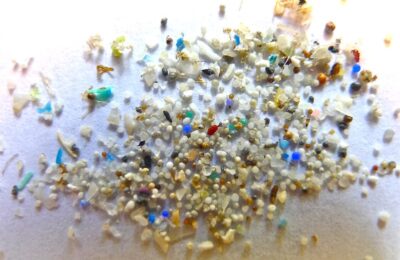Reference: Akhbarizadeh, Razegheh, et al. “Abundance, composition, and potential intake of microplastics in canned fish.” Marine Pollution Bulletin 160 (2020): 111633. https://doi.org/10.1016/j.marpolbul.2020.111633

What are microplastics?
Plastic pollution is an ongoing problem in humanity’s fight for a cleaner environment. Unrecyclable plastic waste piles up in landfills, and sustainable programs for plastic items that can be recycled are becoming harder to come by. On top of all this, another plastic problem comes in the form of microplastics. Microplastics are defined as plastic particles smaller than 5mm long, about the width of a standard drinking straw. These particles are sometimes created this small intentionally, but oftentimes come from larger plastic objects such as clothing, plastic bottles, and even car parts. As these objects break down due to washing, wear and tear, or simply because they were discarded, microplastics are released into the air, water, and soil. These microplastics can then make their way into animals via respiration or ingesting prey, and can potentially work their way up the food chain into human bodies. This begs the question: how many microplastic particles exist in the animal products humans consume, and do they pose great harm to us?

Liquefying lunch
Researchers at the Bushehr University of Medical Studies sought to answer this question in regards to canned fish – a popular food in America, where the average person consumes over 2lbs of canned tuna per year. The team analyzed 50 cans of fish across seven brands and three different fish species. In order to discover if microplastics were present in the cans, the canned fish meat was digested via a mixture of chemicals and heat, and the resulting liquid was filtered. The microplastics caught in this filtration process were then examined under several types of microscope, in order to assure no particle was missed.

Are microplastics prevalent?
In total, 128 total microplastics were found in 40 of the 50 cans. While this means that not every can contained microplastics, those that did contained more than one particle, ranging from 5-22 microplastics per can. There were no differences across brands and species of fish, but it was found that the higher the salt content of the can, the more microplastics were found. This could be evidence that salt is a major contributor of the microplastics present in canned fish. By far, the most abundant microplastics were microfibers, with evidence that many of these fibers originated from synthetic materials used to make clothes and blankets. However, an array of other plastic types were found that are used in everything from plastic water bottles, to food packaging, to fisheries equipment. Using their data, researchers estimated that if an adult has canned fish just once a week, they could be consuming up to 572 microplastic particles per year, a stark figure that raises the concern: Does all this microplastic consumption pose a threat to human health?
What can we do?
Thankfully, it is currently believed that more than 90% of ingested microplastics pass through the body without issue. However, the remaining percentage of microplastics have been shown to cause harm in some cases, leading to inflammation, injuries to the digestive tract, and introduction of pathogens and pollutants into the body. The exact risk of these adverse effects isn’t yet known, and will need to be studied in the future as we combat plastic pollution.
Since it is virtually impossible to avoid encountering microplastics, the best course of action for most of us is to reduce our consumption of items which frequently shed microplastics. This means doing things like choosing all cotton clothing and bedding, using non-plastic reusable water bottles, and recycling plastic when possible so it doesn’t degrade in landfills. By taking these small steps, consumers can start to put microplastics in the spotlight, which will hopefully lead to policy changes across the globe to protect not only the environment, but human health as well.
I received my PhD in Biology from Wake Forest University, and I received a BS in Biology from Cornell University. My research focuses on the terrestrial locomotion of fishes. I am particularly interested in how different fishes move differently on land, and how one fish may move differently in different environments. While I tend to study small amphibious fishes, I’ve had a lifelong fascination with all ocean animals, and sharks in particular. When not doing science, I enjoy running, attempting to bake and cook, and reading.



